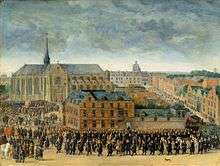Ommegang of Brussels

The Ommegang of Brussels is a traditional Ommegang that nowadays takes place twice a year, at the turn of June and July.
According to legend the origin of the Ommegang goes back to a local devout woman named Beatrijs Soetkens. She had a vision in which the Virgin Mary instructed her to steal the miraculous statue of ‘Onze-Lieve-Vrouw op ‘t Stocxken’ (Our Lady on the little stick) in Antwerp, bring it to Brussels and place it in the chapel of the Crossbow Guild. The woman stole the statue and through some miraculous events was able to bring it to Brussels by boat in 1348. The statue of Mary was then solemnly placed in the chapel and venerated as the patron of the Guild. The Guild promised to hold an annual procession, called an 'Ommegang', in which the statue was carried through Brussels. However, what was originally a religious procession, took on through the following decades gradually a more worldly outlook. From the mid-sixteenth century, the Ommegang not only celebrated the miraculous legend, but became intertwined with the Joyous Entry of Holy Roman Emperor Charles V. The Ommegang thus developed into an important religious and civil event in the annual calendar of Brussels.[1]

Originally it was the largest lustral procession of Brussels, which took place once a year on the Sunday before Pentecost.
The term Ommegang, in Latin "circumambulatio" means "walking around" in Old Flemish and it is an old historical evocation of Brussels. It joins the tradition of the great processions of notable riders and giants that are found everywhere in Belgium and northern France. Its starting point is the Sablon.
References
Further reading
- 1960: Leo van Puyvelde, L'Ommegang de 1615 à Bruxelles, Brussels, Éditions du Marais, 1960.
- 1975: Jean Jacquot, Fêtes et cérémonies au temps de Charles Quint., Fédération internationale des sociétés et instituts pour l'étude de la Renaissance, 1975.
- 1980: Arthur Haulot, Cette nuit-là, l'Ommegang de Bruxelles, Brussels, Ed. Trois Arches, 1980.
- 1997: Daniel Frankignioul (dir.), Brigitte Twyffels, Michel Staes, Claude Flagel, Alfred Willis, Pleins Feux sur l'Ommegang, La Reconstitution du Cortège en 1930 par Albert Marinus., Woluwé-Saint-Lambert, Fondation Albert Marinus, 1997.
- 1997: Rosine De Dijn et Siegfried Himmer, La Grand-Place de Bruxelles, fastueux décor de l'Ommegang, Eupen, Grenz-Echo Editions, 1997.
- 1999: Isabelle Lecomte-Depoorter, Ommegang, with illustrations of René Follet, Éditions Glénat, 1999
- 2007: Olivier de Trazegnies, Louis-Philippe Breydel, L'Ommegang, (trilingual), Brussels, Renaissance du Livre, 2007.